On this Day in History ... 1st August
01 Aug is in August.
Events on the 1st August
On 01 Aug 939 Hugh Maine II Count Maine (age 19), Alan "Twisted Beard" Poher II Duke Brittany (age 39) and Judicael Berengar Penthièvre I Count Rennes defeated the Viking army at Battle of Trans la Foret in Trans-la-Foret freeing Brittany of Viking occupation and leading to the establishment of the Duchy of Brittany.
Anglo-Saxon Chronicle. 1017. This year King Knute (age 22) took to the whole government of England, and divided it into four parts: Wessex for himself, East-Anglia for Thurkyll, Mercia for Edric, Northumbria for Eric. This year also was Earldorman Eadric "Streona aka Acquisitive" Mercia slain at London, and Norman, son of Alderman Leofwin, and Ethelward, son of Ethelmar the Great, and Britric, son of Elfege of Devonshire. King Knute (age 22) also banished Edwy etheling, whom he afterwards ordered to be slain, and Edwy, king of the churls; and before the calends of August the king gave an order to fetch him the widow (age 32) of the other king, Ethelred, the daughter of Richard (age 53), to wife.
On 01 Aug 1137 Louis "Fat" VI King France (age 55) died of dysentery. His son Louis VII King Franks (age 17) succeeded VII King of the Franks. Eleanor of Aquitaine Queen Consort Franks and England (age 15) by marriage Queen Consort Franks.
Annals of Margam. 01 Aug 1202. Rex Johannes (age 35) apud castrum Mirabel cepit Arthurum (age 15) nepotem suum in festum Sancti Petri ad vincula, et cum eo Galfridum de Lizanan1 et Hugonem de Brun2, et Andream de Chavenny, et vice-comitem de castro Haraldi3, et Reymundnm de Troarde, et Savaricum de Maulyon, et Hugonem de Banchai, et omnes alios inimicos suos Pictaviæ, qui ibi erant circiter cc. milites et plures. Ex quibus xxii. nobilissimos et strenuissimos in armis fame interfecit in castello de Corf [Map]; ita quod nec unus ex illis evasit.
King John (age 35) took his nephew Arthur (age 15) in chains at the castle of Mirabel on the feast of Saint Peter, and with Geoffrey de Lusignan1, Hugo the Brown2 and Andream de Chavenny, and Hugh III, viscount of Chastelleraud3, and Reymundnm de Troarde, and Savaricum de Maulyon, and Hugonem de Banchai, and all his other enemies of Poitou, who were around 200 soldiers and more. Of which 22 he killed the noblest and bravest men in arms by starvation in the castle of Corfe [Map]; so that not one of them escaped.
Note 1. Geoffrey de Lusignan (age 52).
Note 2. Hugh de Lusignan (age 19), surnamed le Brun, count de la Marche.
Note 3. Hugh III, viscount of Chastelleraud.
On 01 Aug 1202 King John "Lackland" of England (age 35) defeated the army of his nephew Arthur Plantagenet 3rd Duke Brittany (age 15) and Hugh Lusignan X Count Lusignan V Count La Marche (age 19) which was besieging John's mother Eleanor of Aquitaine Queen Consort Franks and England (age 80) at Mirebeau Castle. King John "Lackland" of England (age 35) took Arthur Plantagenet 3rd Duke Brittany 1187-1203's army by surprise capturing most. Arthur Plantagenet 3rd Duke Brittany (age 15) and, probably, his sister Eleanor "Fair Maid of Britanny" 4th Countess of Richmond (age 18), both of whom arguably had better claims to the throne than King John "Lackland" of England (age 35) were captured.

Letters. 01 Aug 1394. Letter XXVI. Annabella Queen of Scotland (age 44) to King Richard II (age 27).
To the most high and mighty prince Richard, by the grace of God king of England, our very dear cousin, Annabella, by the selfsame grace queen of Scotland sends health and greeting.
We give you hearty and entire thanks for your loving letters presented to as by oar well-beloved Donglas, herald-at-arms, from which we have learned to our great pleasure and comfort your good health and estate. And, dearest cousin, as touching the marriage-treaty to be made between some nearly allied to you by blood and some children of the king my lord and of us, be pleased to know that it is agreeable to the king (age 57) my said lord and to us, as he has signified to you by these letters. And in especial, that, although the said treaty could not be held on the third day of July last past for certain and reasonable causes contained in your letters sent to the king my aforesaid lord, you consented that the treaty should in like manner take place another day, namely, the first day of October next coming, which is agreeable to the king my aforesaid lord and to us; and we thank you heartily aud with good will, and affectionately pray you that you will continue the said treaty, and have the said day kept, for it is the will of my said lord the king and of us that as far as in us lies the said day should be kept without fail. And, dearest cousin, we affectionately require and entreat you that your highness will not be displeased that we have not sooner written to you; for we were lying in childbed of a male infant named James, of whom we are now well and graciously delivered, thanks to God and our Lady. And also, because, at the coming of your letters, the king my said lord was far away in the isles of his kingdom, we did not receive these letters sent to us on this matter till the last day of July last past. Most high and puissant prince, may the Holy Ghost ever keep you! Given under our signet, at the abbey of Dumfermline [Map], the first day of August.
On 01 Aug 1503 Margaret Tudor Queen Scotland (age 13) crossed the border into Scotland at Berwick on Tweed [Map].
Letters and Papers 1528. 01 Aug 1528. Love Letters XVI. 4597. Henry VIII (age 37) to Anne Boleyn (age 27).

Writes to tell her of the great "elengenes" he finds since her departure, "for, I ensure you, me thinketh the time lenger since your departing now last than I was wont to do a whole fortnight." Could not have thought so short an absence would have so grieved him, but is comforted now he is coming towards her; "insomuch that my book maketh substantially for my matter; in token whereof I have spent above four hours this day, which caused me to write the shorter letter to you at this time by cause of some pain in my head. Wishing myself specially an evening in my sweetheart's arms, whose pretty dubbys I trust shortly to cusse.".
On 01 Aug 1549 the rebels defeated a royal army led by William Parr 1st Marquess Northampton (age 37).
On 01 Aug 1587 Mary Queen of Scots was buried at Peterborough Cathedral [Map]. Bishop William Wickham (age 48) preached.
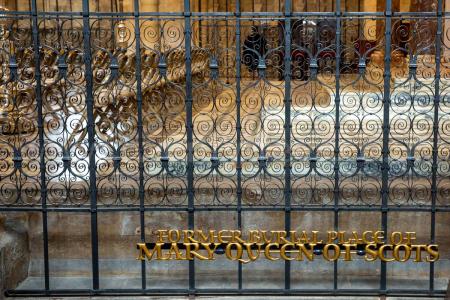
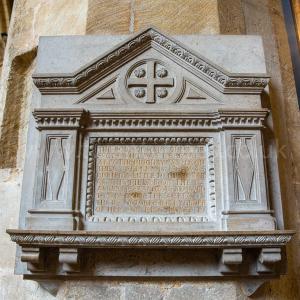
The Letter Books of Amias Paulet Keeper of Mary Queen of Scots Published 1874 Marys Execution. The household of the late Queen were not allowed to depart as soon as Poulet (age 54) expected. They were detained at Fotheringay [Map], from motives of policy, till the 3rd of August, when the funeral of their mistress having been at last performed, they were set free. Some of them were taken to Peterborough [Map] to accompany the corpse and to be present at the funeral ceremonies on the 1st of August. Amongst them, in the order of the procession, it is surprising to find Mary's chaplain, "Monsieur du Preau, aumosnier, en long manteau, portant une croix d'Argent en main." The account of the funeral from which this is taken, written by one of the late Queen's household, takes care to mention that when they reached the choir of Peterborough Minster, and the choristers began "a chanter a leur fagon en langage Anglois," they all, with the exception of Andrew Melville and Barbara Mowbray, left the church and walked in the cloisters till the service was finished. "Si les Anglois," he says, "et principalement le Roy des heraux ... estoit en extreme cholere, d'autant estoient joieux et contents les Catholiques".

Poulet left for London, and as long as Mary's servants were detained at Fotheringay [Map], he seems to have retained jurisdiction over them. It was to him, therefore, that Melville and Bourgoin applied in March for leave to sell their horses and to write into France respecting the bequests made to them by the Queen of Scots; and to him that Darrell forwarded in June "the petition of the whole household and servants of the late Queen of Scotland remaining at Fotheringay," begging to be released from their prison and to be allowed to leave the country.
On 01 Aug 1630 Thomas Clifford 1st Baron Clifford Chudleigh was born to Hugh Clifford of Ugbrooke (age 27) and Mary Chudleigh at Ugbrooke House Chudleigh, Devon.

On 01 Aug 1632 Isabella Rich (age 39) died. Monument at St Andrew's Church, Kimbolton [Map].
Isabella Rich: John Smythe and she were married. She the daughter of Robert Rich 1st Earl Warwick and Penelope Devereux Countess Devonshire. Around 1593 she was born to Robert Rich 1st Earl Warwick and Penelope Devereux Countess Devonshire.
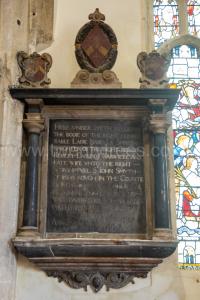
Evelyn's Diary. 01 Aug 1652. Came old Jerome Lennier, of Greenwich, a man skilled in painting and music, and another rare musician, called Mell. I went to see his collection of pictures, especially those of Julio Romano, which surely had been the King's (age 22), and an Egyptian figure, etc. There were also excellent things of Polydore, Guido, Raphael, and Tintoretto. Lennier had been a domestic of Queen Elizabeth, and showed me her head, an intaglio in a rare sardonyx, cut by a famous Italian, which he assured me was exceedingly like her.

Evelyn's Diary. 01 Aug 1662. Mr. H. Howard (age 34), his brothers Charles (age 32), Edward (age 25), Bernard (age 21), Philip (age 33), now the Queen's (age 23) Almoner (all brothers of the Duke of Norfolk, still in Italy), came with a great train, and dined with me; Mr. H. Howard (age 34) leaving with me his eldest and youngest sons, Henry (age 7) and Thomas (age 5), for three or four days, my son, John (age 7), having been sometime bred up in their father's house.

Pepy's Diary. 01 Aug 1664. So to the Coffee-house, and there all the house full of the victory Generall Soushe (age 55)1 (who is a Frenchman, a soldier of fortune, commanding part of the German army) hath had against the Turke; killing 4,000 men, and taking most extraordinary spoil.
Note 1. General Soushe (age 55) was Louis Ratuit, Comte de Souches. The battle was fought at Lewenz (or Leva), in Hungary. B.
Evelyn's Diary. 01 Aug 1666. I went to Dr. Keffler (age 71), who married the daughter of the famous chemist, Drebbell, inventor of the bodied scarlet. I went to see his iron ovens, made portable (formerly) for the Prince of Orange's (age 15) army: supped at the Rhenish Wine-House with divers Scots gentlemen.
Calendars. Oct 1667. 102. Proposals by Sir Thomas Strickland (age 45) to the Navy Comrs., to build three third-rate frigates in Foudray Pill, to be completed by 1 Aug. 1671, upon a similar contract to that of Mr. Baylie, of Bristol. [Adm. Paper.] Enclosing,.
102. i. Edward Tyldesley to Sam. Pepys (age 34). Robt. Withers (age 49) and the writer have viewed Foudray Pill, where they proposed to build ships for the King's service. Sends a draft sketch thereof, leaving the rest of the business to be transacted by his partners, Sir Thomas Strickland (age 45) and Mr. Withers (age 49). Has such timber as all England cannot show. Lodge in the Forest of Meirscough, 01 Oct 1667.
102. ii. Sketch of Walney Island, the pill, bar, &c., in coloured chalks.
On 01 Aug 1671 John Coke (age 35) died. Grave slab at St Withburga's Church, Holkham [Map].
John Coke: On or before 08 Sep 1635 he was born to John Coke and Meriall Wheatley. He was baptised on 08 Sep 1835. Around 1664 Andrew Fountaine became acquainted with John Coke who he apparently saved from drowning. The pair subsequently travelled to the Continent together. Thereafter Andrew Fountaine became steward to John Coke and is reported to have extracted large sums of money from the estate. In 1694 Andrew Fountaine reached a final settlement with the Coke family over the leases given to him by John Coke; all leases and income to be surrendered by Andrew Fountaine in exchange for £10,000. A year later Andrew Fountaine purchased Narford Hall.
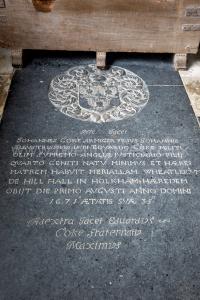
Evelyn's Diary. 01 Aug 1676. In the afternoon, after prayers at St. James's Chapel, was christened a daughter of Dr. Leake's (age 34), the Duke's (age 42) Chaplain: godmothers were Lady Mary (age 14), daughter of the Duke of York (age 42), and the Duchess of Monmouth (age 25): godfather, the Earl of Bath (age 47).


On 01 Aug 1704 Admiral George Rooke (age 54) attacked Gibraltar both by sea and by land (commanded by Prince George of Hesse Darmstadt (age 35)). After the three days of fighting the Spanish surrendered.
On 01 Aug 1714 Queen Anne of England Scotland and Ireland (age 49) died at Kensington Palace. Her second cousin King George I of Great Britain and Ireland (age 54) succeeded I King Great Britain and Ireland. Sophia Dorothea Hanover Queen Consort England (age 47) by marriage Queen Consort England.

On 01 Aug 1730 Frederick Augustus Hervey 4th Earl Bristol was born to John Hervey 2nd Baron Hervey (age 33) and Mary Lepell Baroness Hervey (age 30).
On 01 Aug 1745 Richard Fitzwilliam 7th Viscount Fitzwilliam was born to Richard Fitzwilliam 6th Viscount Fitzwilliam (age 34) and Catherine Decker.

On 01 Aug 1759 William Middleton 5th Baronet (age 21) was severely injured at the Battle of Minden.
George Sackville aka Germain 1st Viscount Sackville (age 43) was ordered several times to advance the British cavalry to complete the victory but refused to do so since Sackville was estranged from Lord Granby (age 38), the force commander, and withheld permission for Granby to "gain glory" through an attack. For this action, he was cashiered and sent home. Sackville refused to accept responsibility for refusing to obey orders. Back in England, he demanded a court martial, and made it a large enough issue that he obtained his demand in 1760. The court found him guilty, and imposed one of the strangest and strongest verdicts ever rendered against a general officer. The court's verdict not only upheld his discharge, but ruled that he was "...unfit to serve His Majesty in any military Capacity whatever", then ordered that their verdict be read to and entered in the orderly book of every regiment in the army. The king had his name struck from the Privy Council rolls.

Archaeologia Volume 15 Section XI Page 128. William Cunnington, Archaeologia, Vol. 15, p.122-26
August 1st, Heytesbury 1803.
The tumulus [Golden Barrow aka Upton Lovell 2e [Map]] opened last Thursday in Upton Lovel parish, is situated a few yards north of the river Wily. It is of a pyramidical form, the base length 58 feet by 38 feet wide [g] and 22 feet in the slope, and stands from east to west. The northside of the barrow is extremely neat, the fouth side is much mutilated. On making a section lengthways on the barrow, at about two feet deep we found in a very shallow cist, human burnt bones piled in a little heap; and at the distance of a foot a considerable quantity of ashes [h] which contained small fragments of human bones; above, and at two feet distant from the bones were found the following articles of pure gold, which are neatly wrought, and highly burnished, viz. about thirteen gold beads made in the form of a drum, having two ends to screw off and perforated in the sides; [i] 2ndly, a thin plate of the same metal 2.25 inches by 5.25 inches; this is very neatly ornamented, as you will see by the annexed drawing: [k] 3dly, a beautiful Bulla (as I conjecture) of a conical form; [l] the inside of this is a solid cone of wood, the gold -which completely covered it is very thin; at the base are two holes for a thread or wire by which it was suspended; near the above were found four articles, viz. two of each, that appeared once to have covered the ends of slaves. [m] Among the gold ornaments lay several flat pieces of amber, the eighth of an inch in thickness, and about an inch wide; there were all perforated lengthways, but were sadly broken in getting out. What is very extraordinary, there were also nearly one thousand amber beads of different sizes. Close to the pile of ashes we found a very small urn, a lance-head of brass, and a pin of the same metal. The urn is of a very extraordinary form, appearing exactly as though it had been stuck all over with small black grapes. In this barrow, contrary to the usual method of interment on the Downs, which are on or in the native soil, we found the cist nearly on the top; and this deviation was probably occasioned from the wetness of the foil, being near the river, or it might have been the manner of interring their great chieftains. From the vail quantity of beads, it might be conjectured that a female had been interred here, but it is well known that our British chiefs wore pearls, beads, etc. On some of the coins of Conobeline we fee beads or pearls on the head. We find in other respects similar method of interment to what we find in many other barrows; the small urn, lance-head of brass, brass pin, etc. are common. From the profusion of valuable ornaments, for valuable they must have been at the period of their interment, we might rationally conclude this barrow to have been the sepulchre of some great chief; in all probability a chief of the Belgic Britons.
I am. Sir,
Your most humble Servant,
William Cunnington.
A. B. Lambert , Esq. Boyton House .
Note g. The length on the top 21 fe
Note h. A circumstance very common.
Note i. See fig. 5.
Note k. You see only a part of this plate: the whole length was about six inches; the pieces broken off had holes in the corners, perhaps used as a bread plate.
Note l. See fig. 1 ; the bafe of this is neatly ornamented
Note m. See fig. 2, 3.
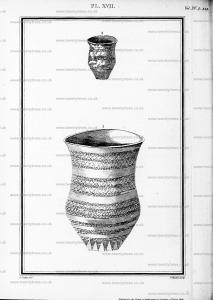
On 01 Aug 1813 Henry Vane-Tempest 2nd Baronet (age 42) died of apoplexy. Baronet Vane of Long Newton in County Durham extinct. Memorial and vault at St Mary's Church, Long Newton [Map] sculpted by Richard Westmacott (age 38).
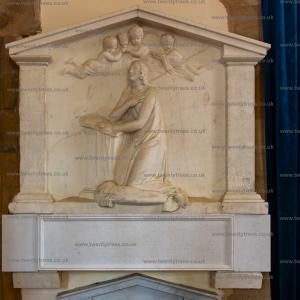
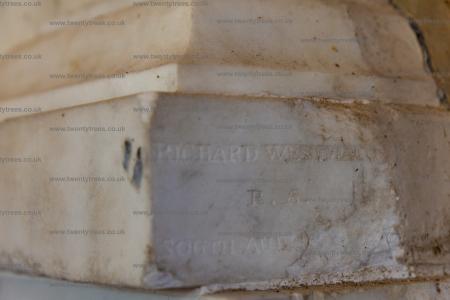
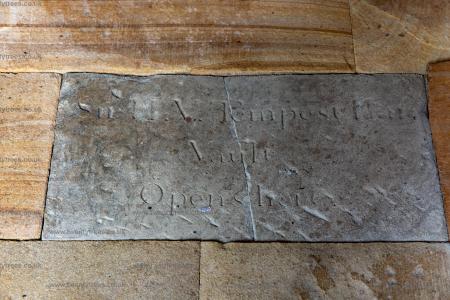
On 01 Aug 1821 Caroline of Brunswick Queen Consort England (age 53) died.
After 01 Aug 1821. St Andrew's Church, Blickling [Map]. Memorial to William Assheton Harbord 2nd Baron Suffield (deceased) erected by his widow Caroline Hobart Baroness Suffield.
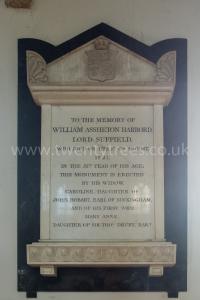
Diary of a Dean by Merewether. 01 Aug 1849. Aug. 1st. The next day was to witness the assemblage of the neighbourhood to inspect Silbury; and this very picturesque event I have already described in the former paper. Our party occupied the morning, till the time of repairing to Silbury, in visiting the barrows lying near Beckhampton, between the Caine and Devizes roads. In some of these, very curious urns and remains had been discovered, some of which I shall describe hereafter; but most appeared to have been disturbed. One high up on the hill in the northern direction was examined, but without success. It would be an indication of ungrateful disrespect —for it could not he forgetfulness —were I to omit, though briefly, to record the employment of the evening of this day, and the route we took; albeit it were well to start somewhat earlier than we did, specially if so splendid a moon as conducted us home might not be reckoned upon. But then, as we had been very fully occupied during the day, some regard was needful to he had toward such discoveries as we might be able to make at the Archæological Hotel, calculated to recruit our exhausted strength, which being satisfactorily accomplished, we proceeded with a very docile pair of horses and driver, both desiderata in such an expedition, first to Oldbury Castle [Map], a splendid position, overlooking the rich vale of Caine, Chippenham, Christian Malford, and Malmsbury, and bearing in its entrenchments the characteristics of Roman occupation, enlarged possibly at some time on the south-west side, but very possibly having been previously a British position, and even subsequently occupied by later warriors. I possess an iron spear-head, and one of those curious circular stones with a hole in the centre, found here. Thence we cut across the down towards the Roman road, the Via Badonica leading from Cunetio [Map] to Aquæ-solis [Map], and which, on arriving at Silbury Hill, which it would otherwise have cut at one-third of its base, deflects its course. We cannot boast that any of the dii deœque minors much less Diana herself, Bivia, Trivia, or whatever she might here have been called of old, were very propitious to us; though, in truth, she made ample amende by her bright guidance, when it was subsequently so much needed. The devotees of Ceres had strangely cut up this ancient road; so that, to traverse it with its full complement was not so easy a matter, either to the wheels of our vehicle, to the poor animals who had to draw it, or, indeed, to its occupants; to say nothing of the conductor. So that we traced the ancient way on foot, and were ready, not unneeded, to replace in its vertical position our tottering and almost subverted equipage, at a spot where the descent to Calston below would have been facile enough per saltum, or per volutationem, for the road in this part runs on the very edge of the abrupt and steep precipice of the hill. After some time spent in these corrective and directive pursuits, having fairly landed the really patient driver on the turf, to seek in advance the summit of the hill, we again became viatores in the strict sense of the word, and in its cognate road, until we reached its junction with the famous Wansdyke, the high vallum of which, in most places from 30 to 40 ft. high, is here and for a considerable distance cut down to fill up the foss and form the road. From this point our explorations were by moonlight, bright as day; we had every reason to be grateful for the propitious aid; by it we traced the some what sinuous range of the Wansdyke; I marked, after thirty years' absence, a barrow almost on its bank, which I had meis manibus excavated some 7 or 8 ft. in depth, finding one solitary glass bead (N), which I still possess. The Wansdyke, ere it makes its turn to the right by Shepherd's shore, forms, without any apparent reason, two right angles; and its trench at this point is very deep, and its vallum marvellously high and steep. From hence we were reluctantly obliged, having succeeded in finding our equipage, to return towards Silbury. Some of our party (and one was a lady, precious as an Archmologist and deserving of all our consideration, as well as her excellent brother) had to return the same night to Marlborough. The plain over which we travelled possesses some earthworks worthy of inspection, especially one enclosing, with an approaching avenue to it, some curious barrows. Towards the right Wansdyke boldly ascends the downs to Tan Hill; some say St. Ann's, others the Hill of Tanaris. The whole of this range is replete with exceeding interest, and Madlv should I be the conductor once more of the whole Archæological Institute amidst its varied treasures.
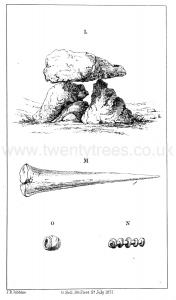
On 01 Aug 1857 Charles Turner (age 82) died.
On 01 Aug 1869 Bishop Walter Kerr Hamilton (age 60) died. Monument in Salisbury Cathedral [Map].
Bishop Walter Kerr Hamilton: On 16 Nov 1808 he was born to Archdeacon Anthony Hamilton. In 1832 Bishop Walter Kerr Hamilton was elected to a Fellowship of Merton College, Oxford University. In 1833 he was appointed Deacon. In 1854 Bishop Walter Kerr Hamilton was elected Bishop of Salisbury.
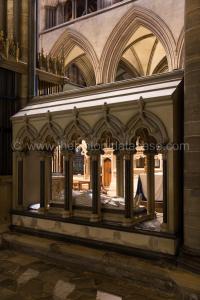
The Times. 01 Aug 1892. The marriage of Mr. Victor Cavendish (age 24), MP, eldest son of the late Lord Edward Cavendish, and nephew and heir presumptive of tho Duke of Devonshire (age 59), to Lady Evelyn Fitzmaurice (age 21), eldest daughter of the Marquis of Lansdowne (age 47), Viceroy of India, took place on Saturday afternoon in St. Margaret's Church, Westminster [Map]. The church was tastefully decorated with flowers. A large crowd assembled outside the church long before half-past 2, the hour fixed for the ceremony, but admittance could only be obtained by those favoured with invitations or tickets. Shortly before 2 o'clock, Mr. Victor Cavendish (age 24) entered by the east door, secompanied by his brother, Mr. Richard Cavendish (age 21), who dlscharged the duties of best man, and took up his position at the chancel steps. Meanwhile the bridesmaids, eight in number, assembled inside the entrance. They were Miss Blanche Egerton (age 21), eldest daughter of the Hon. Francis (age 67) and Lady Louisa Egerton (age 57), cousin of the bridegroom; Lady Francis Spencer Churchill (age 21) eldest daughter of the Marchioness of Blandford, Lady Maud Anson (age 23), daughter of the Earl of Lichfield, Lady Katherine Scott (age 17), daughter of the Duke of Buccleuch (age 60); Lady Gladys Hamilton (age 12), daughter of the Duke of Abercorn (age 53), Miss Muriel Herbert, second cousin of the bride; Lady Dorothy Osborne (age 3), daughter of the Marquis of Carmarthen (age 29); and Miss Margery Digby, daughter of Colonel and Lady Emily Digby (age 37), cousin of the bride.




They were attired alike in dresses of white satin veiled with lisse, the bodices being arranged with fichus having small frills at the edge, and tied in large bows in front, and wore Gainsborough hats trimmed with white feathers and pale pink roses. Each carried a shower bouquet of pink roses and wore a diamond snake brooch, the Cavendish crest, a present from the bridegroom. Master Harry Strettfeild, son of Colonel and Lady Florence Streatfeild (age 32), acted as psge, and wore a costume of white velvet, and a diamond scarf-pin, the bridegroom's gift.
The bride, who arrived punctually at half-past 2, was met at the entrance by the clergy and choir, and a procession being formed, advanced up the aisle, the choristers singing "The voice that breathed o'er Eden" to a setting by Barnby. The Bishop of London, uncle of the bride-groom, performed the nuptial rite, and was assisted in the service by the Rev. John Duncan, M.A., Vicar of CaIne, Wilts, and chaplain to the Marquis of Lansdowne, the Rev. C. Gore and the Rev. H. Rounsell. The music used throughout the service was by Barnby, and included "Jlesn, lover of my soul," from the Hymnary, and "For all the Saints who from their labours rest." The bride, who, in the absence of the Viceroy, was given away by her brother, the Earl of Kerry (age 47), wore a dress of rich white satin duchesse trimmed with beautiful Brussels point lace; the skirt being plainly made, and having a very narrow trimming round the hem. Her tulle veil fell from a wreath of orange flowers and her ornaments included a diamond necklace and a pearl necklace, the gift of her father, thee diamond stars, given by Lady Edward Cavendish, and a fine diamond bracelet, presented to her by the Viceregal Staff in India. At the conclusion of the ceremony the bridal party proceeded to the vestry and signed the registers, the attestors being the Marchioness of Lansdowne (age 42), the Duke of Devonshire (age 59), the Duke of Abercorn (age 53), Lady Edward Cavendish, and the Dowager Maarchioness of Lansdowne, during which the organist plaved the March from St. Polycarp.
The bride, and bridegroom left the church Mendelssohn's Wedding March was played, acd the hells of St. Margaret's rang out a merry peal. The reception was held at ffampden-houlse, lent for the occasion by the Duke and Duchess of Abercorn. In the Lawrence Room was stationed Herr Wurms's White Vienna Band, and refreshments were served in the dining room, the long buffet being profusely decorated with choice white flowers admirably arranged in a number of large silver bowls. Among the company present were the Duke of Devonshire (age 59), the Duke (age 60) and Duchess (age 55) of Bucceuch, the Duke and Duchess of Abercorn, the Duchess Dowager of Abercorn, the Duchess of Leeds and the Ladies Godolphin Osborne, the Dowager Maarchioness of Lansdowne, Lady Edward Cavendish, Lady Frederick Cavendish, the Countess of Kerry, Lord Charles Fitzmaurice, Lord and Lady Edmond Fitzmaurice, the Marchioness of Salisbury and Lady Gwrendolen Cecil, the Marchioness of Blandford and the Ladies Spencer Churchill, the Marquis of Headtort, the Dowager Marchioness of Waterford, the Marchioness of Waterford, the Countess of Normanton and Lady Mary Agar, the Countess of Mayo and Lady Florence Bourke, the Earlof Ava. theEarl and Countess of Morley, and Lady Katherine Parker the Earl and Countess of Minto and the Ladies Elliot Countess Percy and the Ladies Percy, Earl Winterton Countess Spencer, the Earl and Countess of St Germans and Mliss Lascelles, the Earl of Camperdown, Viscount Cross, Viscountess Galway, Viscountess Hampden and the Hon. Miss Brand, Lord Robert Cecil, Lady Alexandra Hamilton, Lady Gladys Hamilton, Lord John Hamnilton, Lord Henry Fitzgerald, LadyHelen Feruson,Lady Li ian Yorkeand Miss Pelly, Lady Rovelstokc and the HIon. M£i5S Baring, Lady George Hamlton, Lady lantage, Lord Frederick Hamilton, the Ladies Egerton, Lord and Lady Alexander Russcll, Lady Constance Scott, Lady Harris, Lady Louisa Blagelis, Lady Beatrix Herbert and Miss Uuriel Herbert, Lady Mauriel Boyle, Lady Lyttelton, Lady Fanny Marjoribanks, Lady Olliffe and Mlliss Olliffe, Lady Abercromby, Lady Claud Hamilton, Lady William Osborne Elphinstone, the Hon. Lady Yoley, the Hon. Charles Gore, Mr. and Mrs. Childers, 1r. Chaplin, the Hon. bliss Roberts and Miss Pryde, Hon. Percy Wyndham and Miss Pamela KWyndham and the.on. MIary lVyndham, the Hon. Thomas Egerton, thec Hon. C. Anson, the Hon. Mrs. Assheton 6?urzon, the Hon. Lionel Holland, the Hon. Alexander Hood, Mlajor the Hon Montagu and M1rs. COrzon, the Hon. Mrs. Agar Ellis, Mr. and Lady Louise Loder, Lady Sybil Beauclerk, Sir James Ramsden, Sir George Baden-Powell Sir Thomas and Lady Brooks, Sir Andrew Scobie, Sir. Henry and Miss James, General Sir Hugh and Lady Gough, Sir Donald Wallace, Colonel and Lady Emily Digby, MIr. and Lady Helena Heneasge, Sir George and Lady Young, General Arthur Ellis, Ilrs. Grenfell, BMrs. Temple, Mr. Hercert, MIrs. Reginald Brett, Miss Chandos Pole, Mr. IV. H. Grenfell, Mrs. Arthur Barclay, Admiral and Mrs. F. Robinson, Mr. Leveson-Gower, Mr. G. Leveson-Gower, Mr. and Mrs. Albert Grey, Mr. Reginald Loder, Mr. Leeson, Colonel Ian and MN rs. Haamilton, Mr. James Cavendish, Mr. and Mrs. Baillie Hamilton, Mr. and Mirs. P. Ponsonby, Mrs. Francis Gore, and many others. Later in the afternoon Mr. and Lady Evelyn Cavendish left for Bowood-park, Lord Lansdowne's seat in Wiltshire, for the honeymoon. Lady Evelyn Cavendish travelled in a dress of ptle blue radzimir, trimmed with white embroidered lisse, with lar-e revers of white moire antique, and wore a large black hat.

The Queen (age 73) presented the bride with an Indian shawl, and the bridegroom with a bronze statuette of herself, with the inscription, "Presented to Victor Cavendish by Victoria, R.I., 1892." The Empress Eugenie gave the bride a ruby and diamond watch bracelet, and Princess Christian presented the bridegroom with 12 volumes of Tennyson's poems, bound in white calf. The other presents to the bride included, from the bridegroom, a superb diamond tiara, an antique chatelaine watch set in diamonds, and a sapphire and diamond bracelet; from the Marchioness of Lansdowne, a diamond necklace and a pearl necklace; the Duke and Duchess of Buecleuch, a diamond and pearl necklace; the Duke of Devonshire, a three-stringed pearl necklace the Ducchess of 'Abercorm, pair of gold links with tucquoise in centre; the Duke of Abercorn, silver and tortoiseshell box; the Dowager Duchess of Abercorn, gold and enamel filagree tulip watch, gold bracelet with motto, and four silver-gilt shell dishes; the Duke of Westminster, a necklace of brilliantts, pink topazes, beryls, and white enamel olira leaves; the MIa-quis of Lansdowne's staff diamond heart bracelet; the Duke and Duchess of St. Albans, pair of amber heart-shaped links with diamond centres; the Duke and Duchess of Bedford, diamond and carbuncle horseshoe brooch: the Dowager M1archioness of Lansdowne, diamond and sapphire thistle brooch the Earl of Mlount Edgeumbe, diamond and sapphire bangle; the Earl of Durham, diamond and sapphire brooch, the Marquis de Lavalette, ring with large pearl in centre and iamonds; La Marquise de Lavalette, diamond flowver brooch; the Earl and Countess of Powis, silver ink-stand and candlesticks; the Earl of Kerry and Lord Charles Fitzmaurice, silver tea service in case; Earl and Countess Winterton, fluted silver bowl; Countess Russell, silver fan-shaped box; the Earl of Rosebery 2 pair of silver candlesticks; the MIarquis of Tullibardine, pair of tortoiseshell and silver opera-glasses the Countess of Lichfield, pair of carved rosewood book shelves; the Countess of Kerry, pair of silver candlesticks; the Marquis of Hamilton, two silver pepper-boxes in case; the Duke of Athole, silver and tortoiseshell inkstand and tray with letter clip; Countess Granville, fitted luncheon basket;fhe MIarquis of Bath, tortoiseshell and silver photo frame Earl and Countess Fitzwilliam, silver-gilt box; the Dowager Marchioness of Waterford, leather dressing-case with silver-gilt fittings; the Earl and Countess of Ilchester, painted lace fan; the Earl of Dalkeith. lace fanD; tnc Eiarl of Northbrook, act of enamelled trays; the Marchioness of Headfort, six fruit knives with malachite handles; the Earl of Ava, crystal seal with diamond-beaded snake entwined; Countess Spencer, pair of large Mintonvases; the MIarchioness ot Blandfora, a framed engraving; Louise, Duchess of Manchester, carriage-basket with clock, &c. the Countess of Minto, Louis XVI. clock; Earl and Coun tess of Wharneliffe, large copper jardiniere on iron stand; Earl and Countess Cowrper, Louis XV clock,; Lord Wolverton silver and copper card-case and memo-book; Lord and Lady Strathrnore. heart-shaped mirror in silver frame; Lord aBnd Lady P.oay, silver trinket tray on stand; Viscount Turnour, silver shell tray; Lady Claud AnSOn, silver tray; Lord and Lady Edmunud Fitzmaurice, pearl and diamond brooch; Viscountess Cranborne ann Lady Esther Gore, gold curb bracelet with crimson enamel heart; Lord and Lady Mount Stephen,. a sable travelling rug; Lady Edward S*vs;di'eA4d tars viacoant Valetort, diamond bracelet: l; dy Robert Cecil and Lady Anne Lambton, pair of gold and malachite links; the Ladies Churchill, silver-mounted heart-shaped tortoise-shell tray; Lady Suffolk, diamond and pearl brooch; Lord Frederick Hamilton, enamel miniature locket set with pearls; Lord Henry Scott, silver tea-caddy the Earl of Caraperdown, silver box; Lord Alington, three-fold screen; Dowager Baroness Ashburton and Mliss Digby, screen; Lord and Lady Roberts, Indian silver bowl; Lady Amnpthill,:gilt carriage clock; Baroness Leconfield, rosewood specimen table; Lord and Baroness Willoughby de Eresby, tortoiseshell and silver tea-caddy; Viscount and Viscountess Cross, hammered silver tray; Lady Abercromby, gold box with enamelled cross and pearl in centre; Lord Revelstoke Savres chin-: vase; Baroness Revelstoke, gold-mounted torto.iseshell paper knife; Lord Rowton, silver-gilt vase; Lady Wantage, Louis XV. clock; Viscount and Viscountess Newport, pair of agate trays; Lord and Lady Ernest Hamilton,two Crorwn Derby ink-pots and tua7; Earl and Countes5 oEf Morley, pair of silver-gilt mounted claret jugs; Lady Beatrice Fitzmaurice, chased silver teapot; Baroness Carrington, silver hot-milk jug-; archioness of Carmarthen, ostrich feather fan; Mrs. 3ontefiore, inlaid cabinet table vith marble top; Hon C Lambton, small silver dish; Mrs. Temple, sil-er bell; Mr Thomas Baring, gold necklace with onys Dendant set. in diamonds; 3r. John Baring, gold curb bracelet with moonstone heart surmonnted with rubies and diamonds; Hon. Miss Baring, diamond and enamel heart brooch; Mrs. Sackville West, gold ball hatpin set with diamonds. Mrs. Grace, silver inkstand and tray; Sir Tatton and Lady Sykes,massive silver-framed:mirror.; Sir Alerander Iackenzie, gold safety-pin brooch set with pearls and diamonds; Captain and Mrs. Cecil Cavendish, silver-mounted pin-cushion; Hon. Mrs Wyndharn, silver buckle Mrr and Lady Fanny hlarioribanks, piece of Indian plate; Mr. and hMrs. W. Grenfell, copper and brass standard lamp; General Brackenbury, large silver-mounted:scent bottle, Mr. and Lady Louise Loder, silver inkstand and tray; MIr. Cyril Flower, large Venetian glass bowl hlr. and Irs. Childers, Dresden china tdte-&-tetc tea service Lord Lansdowne's WViltshire tenants, diamond bracelet. The bridegroom's presents included --From the Duchess of Westminster, tortoiseshell blotting case inlaid with gold; the Marquis and Marchioness of Lansdowne, sl1ver salver; the Marquis of Blandford, silver-gilt card case; the Earl of Chesterfield, silver flask; Mr. R. Cavendish, Eervice of plate in walnut case; the Dowager Marchioness of Lansdowne, large diamond scarf-pin; the Dowrager Duchess of Abercorn, silver cofee pot; the Duke and Duchess of Leeds, gold and bloodstone seal,; the Marquis and Marchioness of Stafford, tortoiseshell and silver calendar frame Lady Frederick Cavendish, 24 volumes of George Eliot's works; the Countess of Bectivo, crystal and gold bos; the Marchioness of Salisbury, pair of tall silver salt cellars and spoons in case; Louise, Duchess of Manchester, silver milk jug; the Marquis of Granby, silver-mounted walking stick; Viscount 'Wolmer, silver-mounted hunting crop; Viscount and Viscountes6 Portman, half-a-dozen silver-gilt dessert spoons in a case; Earl of Arran, gold and nearl Albert chain; Lord and Lady Burton and Hon. ellie Bass, antique silver box; Baroness Taunton, pair of silver candlesticks; Lord Ampthill, massive silver-mounted inkstand; Lord and Lady Henry Bentinek, silver hot milk jug; Sir Thomas asd Baroness Brooke, pair of antique b-rass ornaments; Lord and Lady Herschell, silver-mounted blotter; Hon. W. and Mrs. Cavendish, silver-mounted hock jug; Sir H. and Lady Mleysey Thompson, silver-gilt match box and tray; Hon. A. Lyttelton, silver-mounted riding whip; Hon E. Cavendish, silver grenade cigar lighter; Lord Vernon, silver.tobacco box; Lord and Baroness Chesham, gold and enamel pencil-case Lord and Baroness Penrhyn, four silver salt cellars and spoons; Viscount and Viscountess Hampden, silver coffee-pot; the Earl and Countess of St. toermans, pair of vases; the Countess of Leicester, silver and tortoiseshell scimitar paper cutter; Sir George Baden Powell, silver-mounted ebony stick; Sir Henry James, set of pearl studs; Colonel J. C. Cavendish, silver inkstand; Viscount St. Cyres, silver-mounted walking-stick; Lord and Lady Belper, silver inkstand; Ron. J. Mansfield, silver match-box; Hon. F. Leveson-Gower, two engravings; Earl Spencer, silver sandwich box and flask in casel; Mr and Lady Harriet Cavendish, a silver-mounted driving whip.
On 01 Aug 1893 Alexander I King Greece was born to Constantine I King Greece (age 24) and Sophia Hohenzollern Queen Consort Greece (age 23). He a great grandson of Queen Victoria of the United Kingdom.
On 01 Aug 1895 Reverend Edward Royds (deceased) was buried in the Churchyard of St Oswald's Church, Brereton [Map].
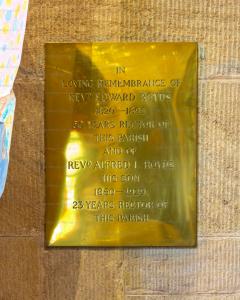
On 01 Aug 2001, Lammas Day, the Ancient Society of College Youths rang the Bells of St Oswald's Church, Brereton [Map] on the occasion of the anniversary of the Medieval Fair held on Brereton Green for three hundred years.
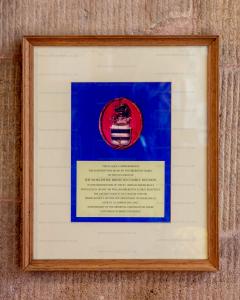
Births on the 1st August
On 01 Aug 1246 Henry Hussey of Harting & Standen was born to Matthew Hussey of Harting and Standen (age 31).
On 01 Aug 1264 Phillip Burnell was born to Hugh Burnell (age 21) at Acton Burnell Castle [Map].
Between 25 May 1334 or 01 Aug 1334 William Vavasour was born to Henry Vavasour (age 42) and Amabel Fitzhugh Baroness Vavasour (age 24).

On 01 Aug 1357 William Fiennes was born to William Fiennes (age 26) and Joan Saye (age 32) at Herstmonceux Castle [Map].

On 01 Aug 1362 Roger Cheney was born to William Cheney (age 34) at Drayton Beauchamp, Buckinghamshire.
On 01 Aug 1365 John Mowbray 1st Earl Nottingham was born to John Mowbray 4th Baron Mowbray Baron Segrave (age 25) and Elizabeth Segrave 5th Baroness Segrave Baroness Mowbray (age 26). He a great x 2 grandson of King Edward "Longshanks" I of England.

Around 01 Aug 1372 Elizabeth Bassett Baroness Grey Codnor was born to Ralph Bassett 1st Baron Basset Sapcote (age 43).
On 01 Aug 1381 Richard Strange 3rd Baron Dunster 7th Baron Strange Knockin was born to John Strange 6th Baron Strange Knockin (age 30) and Maud Mohun Baroness Strange Knockin (age 24).

On 01 Aug 1385 John Fitzalan 13th Earl of Arundel was born to John Fitzalan Baron Maltravers 2nd Baron Arundel (age 20) and Elizabeth Despencer Baroness Zouche, Harringworth, Maltravers and Arundel.

On 01 Aug 1410 Jan IV Count of Nassau was born to Engelbert I Count of Nassau (age 40).
On 01 Aug 1421 Thomas Dutton was born to John Dutton (age 18).
On 01 Aug 1474 Humphrey Pole was born to John de la Pole 2nd Duke of Suffolk (age 31) and Elizabeth York Duchess Suffolk (age 30). He a great x 3 grandson of King Edward III of England.

On 01 Aug 1504 Dorothea Oldenburg was born to King Frederick I of Denmark (age 32) and Anna of Brandenburg (age 16).
On 01 Aug 1520 Sigismund II King Poland was born.
On 01 Aug 1545 Andrew Melville was born.
On 01 Aug 1572 Anne Lennard was born to Samson Lennard Baron Dacre Gilsland (age 28) and Margaret Fiennes 11th Baroness Dacre of Gilsland (age 31) at Chevening, Sevenoaks.
On 01 Aug 1584 Emanuel Scrope 1st Earl of Sunderland was born to Thomas Scrope 10th Baron Scrope of Bolton (age 17) and Philadelphia Carey Baroness Scrope Bolton. He was baptised at St Dunstan's Church, Hunsdon on the 26 Aug 1584 with Queen Elizabeth I of England and Ireland (age 50) as his Godmother.


On 01 Aug 1585 John Knightley was born to Richard Knightley (age 52) and Elizabeth Seymour (age 33).

On 01 Aug 1588 William Sherard 1st Baron Sherard was born to Francis Sherard and Anne Moore at Stapleford, Leicestershire [Map].
On 01 Aug 1591 Lionel Tollemache 2nd Baronet was born to Lionel Tollemache 1st Baronet (age 28) and Katherine Cromwell (age 29).

On 01 Aug 1606 Roger Boyle was born to Richard Boyle 1st Earl Cork (age 39) and Catherine Fenton Countess Cork (age 21) at Youghal, Cork.
On 01 Aug 1609 Elizabeth Calverley was born to George Calverley (age 39) and Mary Cholmondeley (age 24).
On 01 Aug 1614 Henry Drummond was born to John Drummond 2nd Earl Perth (age 26) and Jean Ker Countess Perth.
On 01 Aug 1630 Thomas Clifford 1st Baron Clifford Chudleigh was born to Hugh Clifford of Ugbrooke (age 27) and Mary Chudleigh at Ugbrooke House Chudleigh, Devon.

On 01 Aug 1640 Mundeford Spelman was born to John Spelman (age 33) and Anne Heveningham.
On 01 Aug 1687 Robert Furnese 2nd Baronet was born to Henry Furnese 1st Baronet (age 29) and Anne Brough.
On 01 Aug 1696 William Douglas 2nd Earl March was born to William Douglas 1st Earl March (age 26) and Jean Hay Countess March.

On 01 Aug 1713 Charles I Duke of Brunswick-Wolfenbüttel was born to Ferdinand Albert II Duke of Brunswick-Wolfenbüttel (age 33) and Princess Antoinette of Brunswick-Wolfenbüttel (age 17).
On 01 Aug 1730 Henrietta Pelham Baroness Bergavenny was born to Thomas "Turk" Pelham (age 25).
On 01 Aug 1730 Frederick Augustus Hervey 4th Earl Bristol was born to John Hervey 2nd Baron Hervey (age 33) and Mary Lepell Baroness Hervey (age 30).
On 01 Aug 1732 Thomas Cayley 5th Baronet was born.
On 01 Aug 1736 George Harcourt 2nd Earl Harcourt was born to Simon Harcourt 1st Earl Harcourt (age 22) and Rebecca Samborne Le Bass.
On 01 Aug 1740 Sarah Bradshaw 1st Baroness Waterpark was born.
On 01 Aug 1744 Anne Seymour-Conway Marchioness Drogheda was born to Francis Seymour-Conway 1st Marquess Hertford (age 26) and Isabella Fitzroy Countess Hertford (age 17). She a great x 2 granddaughter of King Charles II of England Scotland and Ireland.

On 01 Aug 1745 Richard Fitzwilliam 7th Viscount Fitzwilliam was born to Richard Fitzwilliam 6th Viscount Fitzwilliam (age 34) and Catherine Decker.

On 01 Aug 1751 George Manners-Sutton was born to George Manners-Sutton (age 28) and Diana Chaplin (age 20).

On 01 Aug 1756 Mary Isabella Somerset Duchess Rutland was born to Charles Noel Somerset 4th Duke Beaufort (age 46) and Elizabeth Berekeley Duchess Beaufort (age 43).

On 01 Aug 1762 Henriette St John was born to Frederick St John 3rd Viscount St John 2nd Viscount Bolingbroke (age 29) and Diana Spencer Viscountess St John and Bolingbroke (age 28).

On 01 Aug 1764 Anna Willing was born to Thomas Willing (age 32) and Anne McCall (age 19).
On 01 Aug 1776 Archibald Acheson 2nd Earl Gosford was born to Arthur Acheson 1st Earl Gosford (age 31) and Millicent Pole Countess Gosford (age 26) at Market Hill
On 01 Aug 1776 Robert Nassau Sutton was born to Richard Sutton 1st Baronet (age 43) and Anne Williams Baroness Sutton.
On 01 Aug 1784 Admiral George Elliot was born to Gilbert Elliot 1st Earl Minto (age 33) and Anna-Maria Amyand Countess Minto (age 32).
On 01 Aug 1797 General William Thomas Knollys was born to William Knollys 8th Earl Banbury (age 34).
On 01 Aug 1806 Edward Crofton 2nd Baron Crofton was born to Edward Crofton 3rd Baronet (age 27) and Charlotte Stewart Lady Crofton (age 29).
On 01 Aug 1813 Frederick William Jerningham was born to William Charles Jerningham (age 40).
On 01 Aug 1821 Augusta Mary Minna Catherine Lyons Duchess Norfolk was born to Edmund Lyons 1st Baron Lyons (age 30) at Torquay, Devon.
On 01 Aug 1822 Mylles Cave-Browne-Cave 11th Baronet was born to John Robert Cave-Browne-Cave 10th Baronet (age 24).
On 01 Aug 1824 Maria Alexandrovna Hesse Darmstadt was born to Louis Hesse Darmstadt II Grand Duke (age 46) and Princess Wilhelmine Baden (age 35). Coefficient of inbreeding 7.03%.
On 01 Aug 1829 Charles Edward Cooke was born to William Bryan Cooke 8th Baronet (age 47) and Isabella Cecilia Middleton Lady Cooke. Coefficient of inbreeding 3.12%.
On 01 Aug 1833 William Victor Leopold Horatio Anson was born to Thomas William Anson 1st Earl Lichfield (age 37) and Louisa Barbara Catherine Phillips Countess Lichfield (age 33).
On 01 Aug 1852 William Reginald Duncombe was born to William Duncombe 1st Earl Feversham (age 23) and Mabel Violet Graham Countess Feversham (age 19). Coefficient of inbreeding 1.57%. 

On 01 Aug 1855 Henry Edward Hotham was born to Reverend Frederick Harry Hotham (age 30).
On 01 Aug 1857 Henry Charles Hardinge 3rd Viscount Hardinge was born to Charles Stewart Hardinge 2nd Viscount Hardinge (age 34) and Lavinia Bingham Viscountess Hardinge (age 21).
On 01 Aug 1857 Rowland Winn 2nd Baron St Oswald was born to Rowland Winn 1st Baron St Oswald (age 37) and Harriet Dumaresq Baroness St Owsald.
On 01 Aug 1862 Daniel Harry Lascelles was born to Henry Thynne Lascelles 4th Earl Harewood (age 38) and Diana Smyth Countess Harewood (age 24).
On 01 Aug 1893 Alexander I King Greece was born to Constantine I King Greece (age 24) and Sophia Hohenzollern Queen Consort Greece (age 23). He a great grandson of Queen Victoria of the United Kingdom.
On 01 Aug 1894 Mona Stapleton 11th Baroness Beaumont and Baroness Howard was born to Miles Stapleton 10th Baron Beaumont (age 44).
On 01 Aug 1894 Edward Digby 11th and 5th Baron Digby was born to Edward Henry Trafalgar Digby 10th and 4th Baron Digby (age 47).
On 01 Aug 1896 Seymour Egerton 6th Earl Wilton was born to Arthur George Egerton 5th Earl Wilton (age 33) and Mariota Thellusson Countess Wilton (age 23).
On 01 Aug 1903 Victoria Mary Villiers was born to Henry Montagu Villiers (age 40).
On 01 Aug 1910 Archie Primrose was born to Albert Archibald Primrose 6th Earl Rosebery 2nd Earl Midlothian (age 28) and Dorothy Grosvenor (age 19). He a great x 3 grandson of King William IV of the United Kingdom.

On 01 Aug 1913 Magdalen Mary Charlotte Fraser Countess Eldon was born to Simon Fraser 14th Lord Lovat (age 41) and Laura Lister (age 21).
On 01 Aug 1914 John Charles William Fitzroy 9th Duke Grafton was born to William Henry Alfred Fitzroy (age 30) and Auriol Margaretta Brougham.
On 01 Aug 1963 Olivia Rose Mildred Fitzroy was born to Hugh Denis Charles Fitzroy 11th Duke Grafton (age 44) and Ann Fortune Smith Duchess Grafton (age 43).
On 01 Aug 1971 George William Eustace Boteler Irby 11th Baron Boston was born to Timothy George Frank Boteler Irby 10th Baron Boston (age 32).
Marriages on the 1st August
On 01 Aug 1235 Gilbert Marshal 4th Earl Pembroke (age 38) and Marjorie Dunkeld Countess Pembroke (age 35) were married at Berwick on Tweed [Map]. She by marriage Countess Pembroke. She the daughter of William "Lion" I King Scotland and Ermengarde Beaumont Sarthe Queen Consort Scotland. He the son of William Marshal 1st Earl Pembroke and Isabel Clare Countess Pembroke. They were half second cousin once removed. She a great x 2 granddaughter of King Henry I "Beauclerc" England. 


Before 01 Aug 1385 John Fitzalan Baron Maltravers 2nd Baron Arundel (age 20) and Elizabeth Despencer Baroness Zouche, Harringworth, Maltravers and Arundel were married. She by marriage Baroness Maltravers, Baroness Arundel. They were half third cousins. He a great x 3 grandson of King Henry III of England. She a great x 3 granddaughter of King Edward "Longshanks" I of England. 

On 01 Aug 1547 Claude Duke of Aumale (age 20) and Louise de Brézé (age 29) were married. He the son of Claude Lorraine 1st Duke Guise (age 50).
On 01 Aug 1548 John de Vere 16th Earl of Oxford (age 32) and Margery Golding Countess of Oxford (age 22) were married at Belchamp St Paul. She by marriage Countess of Oxford. He the son of John de Vere 15th Earl of Oxford and Elizabeth Trussell Countess of Oxford.
After 01 Aug 1558 Simon Harcourt (age 41) and Jane Spencer (age 39) were married.

On 01 Aug 1587 Ralph Okeover and Dorothy Bagot (age 25) were married at Blithfield, Rugeley.
Before 01 Aug 1588 Francis Sherard and Anne Moore were married.
On 01 Aug 1601 John Hoskyns of Hereford (age 35) and Benedicta Moyle were married. They had three sons (two of whom predeceased him) and one daughter.
On 01 Aug 1615 John Tracy 2nd Viscount Tracy (age 22) and Bridget Lyttelton were married.
Before 01 Aug 1630 Hugh Clifford of Ugbrooke (age 27) and Mary Chudleigh were married.

Before 01 Aug 1640 John Spelman (age 33) and Anne Heveningham were married.
On 01 Aug 1644 Henry Grey 10th Earl Kent (age 49) and Amabel Benn Countess Kent (age 36) were married. She by marriage Countess Kent. He the son of Anthony Grey 1453-1490 9th Earl Kent and Magdelane Purefoy Countess Kent (age 72).
On 01 Aug 1671 Henry Cadogan (age 29) and Bridget Waller (age 32) were married.
On 01 Aug 1672 Henry Fitzroy 1st Duke Grafton (age 8) and Isabella Bennet Duchess Grafton (age 4) were married. She the daughter of Henry Bennet 1st Earl Arlington (age 54) and Elisabeth Nassau Beverweert Countess Arlington (age 38). He the illegitmate son of King Charles II of England Scotland and Ireland (age 42) and Barbara Villiers 1st Duchess of Cleveland (age 31).

He was created 1st Earl Euston, 1st Viscount Ipswich, 1st Baron Sudbury. Isabella Bennet Duchess Grafton (age 4) by marriage Countess Euston.
Before 01 Aug 1696 William Douglas 1st Earl March (age 26) and Jean Hay Countess March were married. She the daughter of John Hay 1st Marquess Teviotdale (age 70) and Jean Scott Marchioness Teviotdale. He the son of William Douglas 1st Duke Queensberry and Isabel Douglas Countess Queensberry. They were fourth cousins.


Around 01 Aug 1697 Robert Constable 3rd Viscount Dunbar (age 46) and Dorothy Brudenell Viscountess Dunbar (age 54) were married. She by marriage Viscountess Dunbar. She the daughter of Robert Brudenell 2nd Earl Cardigan (age 90) and Anna Savage Countess Cardigan. They were first cousins.


Around 01 Aug 1697 William Constable 4th Viscount Dunbar (age 43) and Elizabeth Clifford Viscountess Dunbar (age 8) were married. The difference in their ages was 35 years.

After 01 Aug 1721 Thomas Herbert 8th Earl Pembroke 5th Earl Montgomery (age 65) and Mary Howe Countess Pembroke and Montgomery were married. She by marriage Countess Pembroke, Countess Montgomery. He the son of Philip Herbert 5th Earl Pembroke 2nd Earl Montgomery and Catherine Villiers Countess Pembroke and Montgomery.

On 01 Aug 1754 William Anne Capell 4th Earl Essex (age 21) and Frances Hanbury Williams Countess Essex were married. She by marriage Countess Essex. He the son of William Capell 3rd Earl Essex and Elizabeth Russell Countess Essex (age 43).
On 01 Aug 1766 Thomas Broughton 6th Baronet (age 21) and Mary Wicker Lady Boughton were married. She by marriage Lady Broughton of Broughton in Staffordshire.
On 01 Aug 1767 Charles Howard 11th Duke of Norfolk (age 21) and Marion Coppinger were married. He the son of Charles Howard 10th Duke of Norfolk (age 46) and Catherine Brockholes Duchess Norfolk (age 49).
On 01 Aug 1797 Thomas Pilkington 7th Baronet (age 23) and Elizabeth Anne Tufnel Lady Pilkington were married. She by marriage Lady Pilkington of Stanley in Yorkshire.
On 01 Aug 1804 George Richard St John 4th Viscount St John 3rd Viscount Bolingbroke (age 43) and Isabella Charlotte Hompesch Baroness von Hompesch (age 28) were married at Trinity Church, Manhattan.
On 01 Aug 1818 Ambrose Goddard of the Lawn in Swindon (age 39) and Jacinta Dorothea Lethbridge (age 22) were married.
On 01 Aug 1825 Charles Stourton 19th Baron Stourton (age 23) and Mary Lucy Clifford Baroness Stourton (age 25) were married. She a great x 3 granddaughter of King Charles II of England Scotland and Ireland. 

On 01 Aug 1826 George Brooke-Pechell 4th Baronet (age 37) and Katharine Anabella Bisshop Lady Brooke-Pechell (age 34) were married at Parham Park, Sussex.
On 01 Aug 1827 James Doughty-Tichborne 10th Baronet (age 43) and Henriette Felicite Seymour Lady Tichborne (age 24) were married at St George's Church, Hanover Square.
On 01 Aug 1831 George Augustus Francis Rawdon-Hastings 2nd Marquess Hastings (age 23) and Barbara Yelverton Marchioness Hastings (age 21) were married. He the son of Francis Rawdon-Hastings 1st Marquess Hastings and Flora Mure-Campbell Marchioness of Hastings (age 51).
On 01 Aug 1835 John Skeffington 10th Viscount Massereene, 3rd Viscount Ferrard (age 22) and Olivia Grady Viscountess Massereene were married. She by marriage Viscountess Massereene. They had four sons and four daughters.
On 01 Aug 1850 Arthur George Onslow (age 30) and Katherine Anne Cust (age 28) were married. She the daughter of John Cust 1st Earl Brownlow (age 70) and Caroline Fludyer Countess Brownlow. He the son of Arthur George Onslow 3rd Earl Onslow (age 72) and Charlotte Hanmer Countess Onslow.
On 01 Aug 1855 Francis Charles Fitzroy (age 44) and Harriet Anne Musgrave were married. He a great x 4 grandson of King Charles II of England Scotland and Ireland. 

On 01 Aug 1863 Henry Winston Barron 1st Baronet (age 67) and Augusta Anne Somerset Lady Barron (age 39) were married at St George's Church, Hanover Square. She by marriage Lady Barron of Glenanna and Barroncourt in County Waterford. The difference in their ages was 28 years.
On 01 Aug 1883 Reverend Charles Dundas and Louisa Maria Boothby (age 77) were married.
On 01 Aug 1891 Charles Noel Carnegie 10th Earl of Southesk (age 37) and Ethel Mary Elizabeth Bannerman Countess Southesk (age 23) were married. He the son of James Carnegie 9th Earl Southesk (age 63) and Catherine Hamilton Noel.
On 01 Aug 1903 George Vivian 4th Baron Vivian (age 25) and Barbara Cicely Fanning Baroness Vivian were married. She by marriage Baroness Vivian of Glynn and Truro in Cornwall.
Deaths on the 1st August
On 01 Aug 1137 Louis "Fat" VI King France (age 55) died of dysentery. His son Louis VII King Franks (age 17) succeeded VII King of the Franks. Eleanor of Aquitaine Queen Consort Franks and England (age 15) by marriage Queen Consort Franks.
Around 01 Aug 1177 William Saye (age 44) died at Kimbolton.
On 01 Aug 1190 Floris Gerulfing III Count Holland (age 49) died at Antioch.
On 01 Aug 1345 Richard Pole (age 50) died.
On 01 Aug 1359 John Harrington of Farleton (age 59) died.
On 01 Aug 1361 Henry Lisle (age 56) died.
On 01 Aug 1364 Robert Pembridge (age 50) died at Holland, Lancashire.
On 01 Aug 1370 Robert Erpingham (age 40) died at Erpingham, Norfolk.
On 01 Aug 1402 Edmund of Langley 1st Duke of York (age 61) died at King's Langley, Hertfordshire [Map]. His son Edward York 2nd Duke of York 1st Duke Albemarle (age 29) succeeded 2nd Duke York, 2nd Earl Cambridge and inherited his estates which included Conisbrough Castle [Map]. Philippa Mohun Duchess Albemarle aka Aumale Duchess York (age 35) by marriage Duchess York.

On 01 Aug 1418 Richard Grey 1st or 4th Baron Grey of Codnor (age 47) died. His son John Grey 2nd or 5th Baron Grey of Codnor (age 22) succeeded 2nd or 5th Baron Grey of Codnor.
On 01 Aug 1418 John Hende died.
On 01 Aug 1455 Eleanor Berkeley Countess Arundel (age 73) died.
On 01 Aug 1464 John Fettiplace of Childrey (age 37) died.
On 01 Aug 1464 Cosimo de Medici "The Elder" (age 74) died.
On 01 Aug 1474 Walter Blount 1st Baron Mountjoy (age 58) died. His grandson Edward Blount 2nd Baron Mountjoy (age 10) succeeded 2nd Baron Mountjoy.
On 01 Aug 1476 Henry Fiennes 3rd Baron Saye and Sele (age 30) died at Broughton Castle, Oxfordshire. His son Richard Fiennes 4th Baron Saye and Sele (age 5) succeeded 4th Baron Saye and Sele.
On 01 Aug 1507 Elizabeth Burgh Baroness Fitzhugh died.
On 01 Aug 1510 Anne de Semarc (age 77) died.
Before 01 Aug 1529 William Digby of Ab Kettleby in Leicestershire (age 49) died.
Around 01 Aug 1538 Edmund Harvey (age 46) died.
On 01 Aug 1551 George Waldegrave (age 41) died.
On 01 Aug 1551 Michael Lyster died.
On 01 Aug 1558 Richard Brydges (age 58) died.
On 01 Aug 1582 Elizabeth Peirson died.
On 01 Aug 1587 George Clifton (age 21) died.
On 01 Aug 1591 Thomas Stanley (age 60) died.
On 01 Aug 1597 Henry Fitzgerald 12th Earl of Kildare (age 35) died. His brother William Fitzgerald 13th Earl of Kildare succeeded 13th Earl Kildare.
On 01 Aug 1603 Matthew Browne (age 40) was killed in a duel with John Townshend (age 35) at Hounslow Heath [Map]. Matthew Browne (age 40) died the following day.

On 01 Aug 1605 Edmund Anderson (age 80) died at Eyeworth.
Around 01 Aug 1605 Katherine Babington (age 90) died at Croxall, Staffordshire.
On 01 Aug 1624 Edward Dymoke (age 66) died at St Martin in the Fields [Map].
On 01 Aug 1632 Isabella Rich (age 39) died. Monument at St Andrew's Church, Kimbolton [Map].
Isabella Rich: John Smythe and she were married. She the daughter of Robert Rich 1st Earl Warwick and Penelope Devereux Countess Devonshire. Around 1593 she was born to Robert Rich 1st Earl Warwick and Penelope Devereux Countess Devonshire.

On 01 Aug 1639 Thomas Thynne (age 61) died.
Around 01 Aug 1641 Anne Clopton (age 29) died.
On 01 Aug 1671 John Coke (age 35) died. Grave slab at St Withburga's Church, Holkham [Map].
John Coke: On or before 08 Sep 1635 he was born to John Coke and Meriall Wheatley. He was baptised on 08 Sep 1835. Around 1664 Andrew Fountaine became acquainted with John Coke who he apparently saved from drowning. The pair subsequently travelled to the Continent together. Thereafter Andrew Fountaine became steward to John Coke and is reported to have extracted large sums of money from the estate. In 1694 Andrew Fountaine reached a final settlement with the Coke family over the leases given to him by John Coke; all leases and income to be surrendered by Andrew Fountaine in exchange for £10,000. A year later Andrew Fountaine purchased Narford Hall.

On 01 Aug 1682 George Devereux (age 66) died.
On 01 Aug 1682 Robert Delaval (age 35) died. He was buried at St George's Chapel, Windsor Castle [Map].
On 01 Aug 1683 Richard Corbet 2nd Baronet (age 43) died. His son Uvedale Corbet 3rd Baronet (age 15) succeeded 3rd Baronet Corbet of Leighton in Montgomeryshire.
On 01 Aug 1692 John Carew 3rd Baronet (age 56) died. His son Richard Carew 4th Baronet (age 9) succeeded 4th Baronet Carew of Antony in Cornwall.
On 01 Aug 1695 Elizabeth Willoughby Countess Ranelagh (age 62) died.
On 01 Aug 1702 William Courtenay 5th Earl Devon (age 73) died. His grandson William Courtenay 6th Earl Devon (age 26) de jure 6th Earl Devon.
On 01 Aug 1708 Dr Edward Tyson (age 57) died.
On 01 Aug 1712 Hugh Willoughby 12th Baron Willoughby of Parham (age 72) died. His nephew Edward Willoughby 13th Baron Willoughby of Parham succeeded 13th Baron Willoughby Parham.
On 01 Aug 1714 Queen Anne of England Scotland and Ireland (age 49) died at Kensington Palace. Her second cousin King George I of Great Britain and Ireland (age 54) succeeded I King Great Britain and Ireland. Sophia Dorothea Hanover Queen Consort England (age 47) by marriage Queen Consort England.

On 01 Aug 1721 Barbara Slingsby Countess Pembroke and Montgomery (age 53) died.
On 01 Aug 1745 John Chudleigh 6th Baronet died. Baronet Chudleigh of Ashton in Devon extinct.
On 01 Aug 1749 Richard Temple (age 23) died.
On 01 Aug 1749 Henry Hare 3rd Baron Coleraine (age 56) died. Baron Coleraine extinct. He left his Tottenham estates to his illegitimate daughter Henrietta Rosa Peregrina (age 3) but as a consequence of her being a alien the estates escheated to the Crown.
On 01 Aug 1755 Robert Grosvenor 6th Baronet (age 60) died. His son Richard Grosvenor 1st Earl Grosvenor (age 24) succeeded 7th Baronet Grosvenor of Eaton in Cheshire.
On 01 Aug 1772 Anne Perceval died.
On 01 Aug 1779 Charles Mordaunt 4th Earl Peterborough 2nd Earl Monmouth (age 71) died. His son Charles Henry Mordaunt 5th Earl Peterborough 3rd Earl Monmouth (age 21) succeeded 5th Earl Peterborough, 3rd Earl Monmouth, 10th Baron Mordaunt, 4th Viscount Mordaunt of Avalon, 4th Baron Mordaunt of Reigate.
On 01 Aug 1783 Edward Devereux 12th Viscount Hereford (age 43) died. His brother George Devereux 13th Viscount Hereford (age 39) succeeded 13th Viscount Hereford, 10th Baronet Devereux of Castle Bromwich. Marianna Devereux Viscountess Hereford by marriage Viscountess Hereford.
On 01 Aug 1800 John Chichester (age 48) died.
On 01 Aug 1808 Diana Spencer Viscountess St John and Bolingbroke (age 74) died.
01 Aug 1810 Thomas Weld (age 59) died.
On 01 Aug 1811 Catherine Gordon 13th of Gight Gordon (age 46) died.
On 01 Aug 1813 Henry Vane-Tempest 2nd Baronet (age 42) died of apoplexy. Baronet Vane of Long Newton in County Durham extinct. Memorial and vault at St Mary's Church, Long Newton [Map] sculpted by Richard Westmacott (age 38).



On 01 Aug 1814 Anne Barbara Whitworth Lady Russell died.
On 01 Aug 1821 William Assheton Harbord 2nd Baron Suffield (age 54) died. His brother Edward Harbord 3rd Baron Suffield (age 39) succeeded 3rd Baron Suffield, 4th Baronet Harbord of Suffield in Norfolk. Georgiana Venables-Vernon Baroness Suffield (age 35) by marriage Baroness Suffield.
On 01 Aug 1821 Caroline of Brunswick Queen Consort England (age 53) died.
On 01 Aug 1830 Mary-Stanley-Massey-Stanley (age 77) died.
On 01 Aug 1836 Mary Sandys Marchioness Downshire (age 72) died.
On 01 Aug 1857 Charles Turner (age 82) died.
On 01 Aug 1858 Lieutenant-General Frederick Ashworth died.
On 01 Aug 1868 Richard Boyle 4th Earl Shannon (age 59) died. His son Henry Bentinck Boyle 5th Earl Shannon (age 34) succeeded 5th Earl Shannon. Blanche Emma Lascelles Countess Shannon by marriage Countess Shannon.

On 01 Aug 1869 Bishop Walter Kerr Hamilton (age 60) died. Monument in Salisbury Cathedral [Map].
Bishop Walter Kerr Hamilton: On 16 Nov 1808 he was born to Archdeacon Anthony Hamilton. In 1832 Bishop Walter Kerr Hamilton was elected to a Fellowship of Merton College, Oxford University. In 1833 he was appointed Deacon. In 1854 Bishop Walter Kerr Hamilton was elected Bishop of Salisbury.

On 01 Aug 1869 Belinda Brummell (age 52) died.
On 01 Aug 1882 Princess Marie-Félix Blanc (age 22) died.
On 01 Aug 1886 Colonel Henry Skipwith (age 71) died.
On 01 Aug 1887 Hugh Cholmondeley 2nd Baron Delamere (age 75) died. His son Hugh Cholmondeley 3rd Baron Delamere (age 17) succeeded 3rd Baron Delamere of Vale Royal in Cheshire. Florence Ann Cole Baroness Delamere (age 9) by marriage Baroness Delamere of Vale Royal in Cheshire.
On 01 Aug 1898 William David Murray 4th and 3rd Earl Mansfield (age 92) died. His grandson William Murray 5th and 4th Earl Mansfield (age 38) succeeded 5th Earl Mansfield in Middlesex, 4th Earl Mansfield in Nottinghamshire, 10th Viscount Stormont.
On 01 Aug 1913 George Francis Howard (age 73) died.
On 01 Aug 1913 Fitzroy Talbot Clayton of Fyfield House in Maidenhead (age 79) died.
On 01 Aug 1917 Captain Louis Edwin William Egerton (age 36) was killed in action.
On 01 Aug 1928 Mary Katharine Isabella Hervey died.
On 01 Aug 1942 Albert Harry George Campbell Grey (age 30) died whilst on active service.
On 01 Aug 1978 Fergus Frederick Graham 5th Baronet (age 85) died. His son Charles Spencer Richard Graham 6th Baronet (age 59) succeeded 6th Baronet Graham of Netherby in Cumberland.